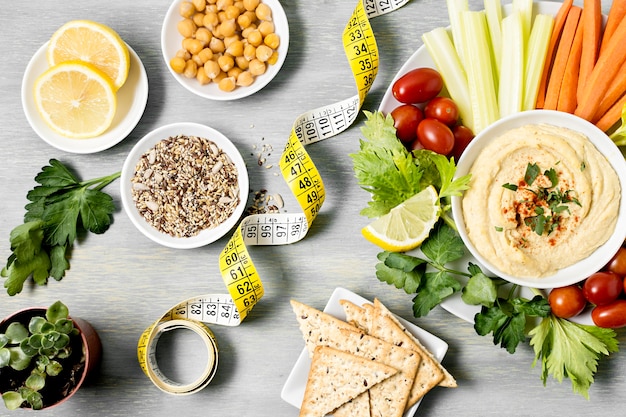
Quick Tips to Start a Low Glycemic Diet
The low glycemic diet is designed to help lower blood sugar levels, but it’s also effective for those looking to lose weight or improve their overall health. If you think a low glycemic eating plan could benefit you, here are some tips to get started:
Familiarize Yourself with the Glycemic Index (GI)
Use an app on your phone or an online reference to get familiar with the glycemic index.
Limit High-GI Carbohydrates
Focus on eating more low-GI carbs and limit high-GI ones.
Choose Natural, Unprocessed Foods
Opt for whole grains, fruits, and cruciferous vegetables.
Swap Out High-GI Foods
Replace white-flour bread, crackers, and pasta with whole-grain, lower GI varieties. Swap white potatoes for sweet potatoes.
Incorporate Legumes
Embrace beans, lentils, and chickpeas as they are nutrient-rich and low-GI.
Stay Hydrated
Drink plenty of water and avoid sugary, high-GI drinks like sodas and juices.
Make Wise Protein and Fat Choices
Although the diet has no strict rules on protein or fats, it’s important to choose wisely.
Suitable for Vegans and Vegetarians
A low-glycemic diet can be adapted for both vegans and vegetarians.
What Is the Low-Glycemic Diet?
The low-glycemic diet is based on selecting foods that rank lower on the glycemic index (GI). The GI helps you distinguish between good and bad carbs by rating how they affect blood sugar levels. When you eat carbohydrates, your body breaks them down into glucose, which provides energy. Different foods release glucose into the bloodstream at different rates. High-glycemic foods cause quick spikes and crashes in blood sugar levels, while low-glycemic foods release glucose more steadily, providing numerous health benefits.
Unlike diets that focus on calorie or carbohydrate counting, the low-glycemic diet emphasizes paying attention to the GI values of foods. Your diet will mostly consist of low- and medium-GI foods, with high-GI foods consumed in moderation.
What Is the Glycemic Index?
The glycemic index measures how a particular food affects your blood sugar level after eating. The scale ranges from 0 to 100:
– Low GI foods: below 55
– Medium GI foods: 56-69
– High GI foods: 70 or higher
High-GI foods cause quick spikes in blood sugar, prompting the pancreas to release insulin, which causes fat cells to absorb glucose. Low-GI foods maintain a steady blood sugar level. However, some high-GI foods like watermelon may still be suitable if you consider their glycemic load, which takes into account the total calories and grams of carbs per serving.
What Is Glycemic Load?
Glycemic load (GL) provides a more accurate representation of a food’s impact on blood sugar levels by considering the GI value and the carbohydrate grams per serving. Some foods high on the GI scale have low GL due to their small portion sizes. You can calculate GL by multiplying the GI score by the carbohydrate grams per serving and then dividing by 100.
– Low GL foods: 0-10
– Medium GL foods: 11-20
– High GL foods: 21-30
Foods You Can Eat
A low glycemic diet offers a wide variety of delicious and nutritious foods. Here are some examples:
Vegetables
Cruciferous vegetables like broccoli, cabbage, Brussels sprouts, and cauliflower have low GI and GL scores. Other vegetables, such as lettuce, are nutrient-rich and maintain steady blood sugar levels.
Legumes
Legumes, including lentils, peas, and beans, are low-GI and high in complex carbohydrates. Healthy options include black beans, kidney beans, navy beans, and garbanzo beans.
Bread & Grains
You don’t have to avoid bread on a low-GI diet. Look for whole-grain bread and steel-cut oatmeal.
Fruit
Fruits, though sweet, generally have a low glycemic load due to their high fiber content. Opt for high-fiber fruits like apples and bananas. While melons have a higher GI, their glycemic load is low.
Other Low-GI Options
Include whole grain pasta, oatmeal, muesli, and sweet potatoes. Foods with healthy fats and proteins help create a balanced diet.
While meat can be included, a plant-based diet offers more health benefits, reducing the risk of heart disease and chronic illnesses.
Foods to Avoid
Avoid processed foods high in refined sugar and those with high GI and GL values. Here are some foods to avoid:
Refined Grains
Steer clear of processed white bread, highly processed cereals, and instant oatmeal. Choose whole grain options like barley, quinoa, and buckwheat instead.
Added Sugar
Refined white sugar and high-fructose corn syrup should be avoided. Instead, use natural low-calorie sweeteners like Stevia leaf or monk fruit.
Gluten-Free Considerations
Remember, gluten-free does not necessarily mean low-GI. Check labels carefully as many gluten-free foods are highly processed.
Example Low Glycemic Diet Meal Plan
Day One
– Breakfast: Steel cut oatmeal with fruit
– Lunch: Whole grain tortilla with black beans, avocado, and salsa
– Dinner: Green lentil salad with spiced carrots
Day Two
– Breakfast: Buckwheat pancakes with berries
– Lunch: Winter squash soup with quinoa
– Dinner: Vegetable stir-fry over brown rice
Day Three
– Breakfast: Fresh fruit
– Lunch: Vegan mock tuna in lettuce wraps
– Dinner: Sweet and savory Buddha bowl
Mix and match low-GI foods to create meals that suit your palate. Use the glycemic index and glycemic load index to guide your choices.
Health Benefits of a Low-Glycemic Diet
Following a low-glycemic diet can help lower cholesterol, improve blood pressure, and prevent heart disease. Here are some specific health benefits:
Maintains Normal Blood Sugar Levels
A steady release of glucose can prevent type 2 diabetes or help manage it. Studies show that a low-glycemic diet significantly reduces the risk of developing type 2 diabetes and helps manage blood glucose levels.
Aids Weight Loss
Low-glycemic foods help manage appetite and avoid blood sugar spikes, aiding in weight maintenance. Combined with high protein intake, they help people lose weight and keep it off.
Improves Heart Health
A low-glycemic diet can lower cholesterol, manage hypertension, and reduce the risk of heart attack and stroke. High-GI and high-GL diets increase the risk of heart disease, particularly in women.
Low Glycemic vs. Low Carb
Low-glycemic and low-carb are not the same. Low-carb does not necessarily mean low-GI. Some low-carb foods have high GI scores, leading to blood glucose spikes. Conversely, legumes are high in carbs but low in GI.
Can You Be Vegan or Vegetarian on the Low-GI Diet?
Yes, the low-glycemic diet is ideal for vegetarians and vegans. It allows for a varied plant-based diet with leafy vegetables, whole grains, nuts, seeds, and fruits. Meats are optional since the diet focuses on carbohydrate-based foods.
Side Effects & Safety
While the low-glycemic diet is not specifically low-carb, some people might experience side effects like fatigue, headaches, constipation, or nutritional deficiencies. Consult a healthcare professional if you experience these issues.
Is Low-Glycemic Right for You?
The low-glycemic diet is beneficial for those managing blood sugar for health reasons, whether managing diabetes or preventing it. It can also help with weight loss and improving overall health, especially when combined with exercise and a high-fiber diet.
Points to Remember
A low-glycemic diet helps regulate blood glucose levels and control appetite, aiding in weight loss and reducing the risk of heart disease and metabolic disorders. It’s a practical approach to achieving better health and managing conditions like diabetes.



